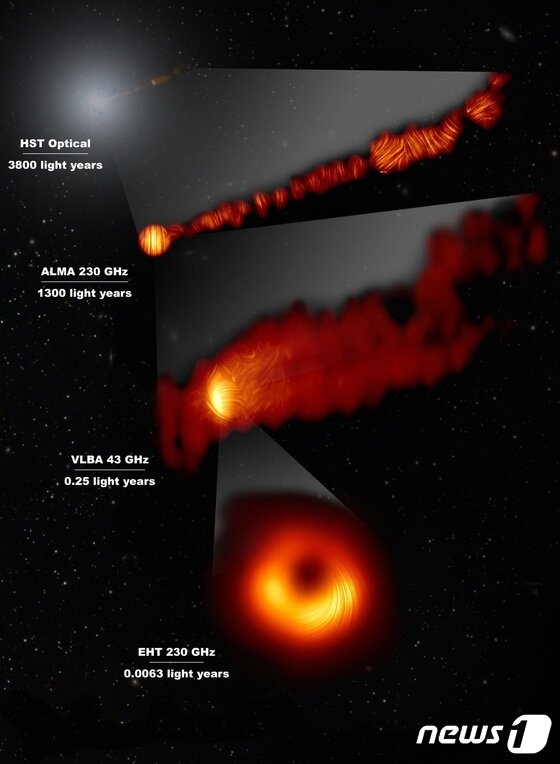 |
| Polarized image of a supermassive black hole in the center of the M87 galaxy, released by the EHT International Collaborative Research Team. The bright spiral lines show the direction of polarization relative to the magnetic field around the M87 black hole. |
The event horizon telescope (EHT) international joint research team, which released the first black hole image, also released an observation image of the polarization (light vibrating only in a specific direction) of a supermassive black hole in the center of the M87 galaxy.
This is the first time astronomers have been able to observe polarization, which is evidence of a strong magnetic field at the edge of a black hole. These observations are key to explaining how the M87 galaxy, 55 million light-years away, can emit high-energy jets from its core nucleus.
According to the Korea Astronomical Research Institute on the 24th, black holes emit enormous energy while attracting matter from their surroundings.
However, it has not been known what the mechanism of mass inflow and emission around a black hole is, and how jets larger than the size of a galaxy can occur at the center of a giant elliptical galaxy such as M87.
On April 10, 2019, the EHT research team, which includes more than 300 researchers from 65 institutions around the world, including Korea, released an image of a black hole in the center of M87, which belongs to the Virgo galaxy for the first time. It showed a light ring-shaped structure with a dark center area, i.e. the shadow of a black hole.
Subsequently, the research team conducted continuous observation and analysis on the M87, and found that this time around a large portion of the light around the M87 black hole is polarized.
Polarization observation is one way to check the amount of material inflow just outside the black hole. This polarization observation image clearly shows that the ring of light at the edge of the M87 black hole is strongly magnetized.
As a result of analyzing this polarization observation image, the research team found that a much stronger magnetic field exists around the black hole than expected. Through the magnetic field structure, it is possible to confirm in detail the region where the inflow and outflow of matter occurs just outside the black hole.
Professor Jason Dexter of the University of Colorado Boulder, USA, who is the head of the EHT Theoretical Research Group, emphasized, “Through this video, we can present a new hypothesis about how the strong magnetic field around the M87 black hole contributes to the formation of supermassive black holes and jets.” did.
“Some of the hot gas around the M87 black hole overcomes the strong gravitational energy at the center of the black hole by the pressure of the strong magnetic field at the edge and is pushed outward and flies in the form of a jet in the distance.” ”He explained.
Dr. Jongho Park of the Taipei Astrophysics Institute in Taiwan said, “We expect future EHT observations to more accurately reveal the structure of the magnetic field around the black hole and reveal more about the properties of the material around the black hole.”
Meanwhile, the results of this study were published in two papers on the 24th of the Journal of Astrophysics.
